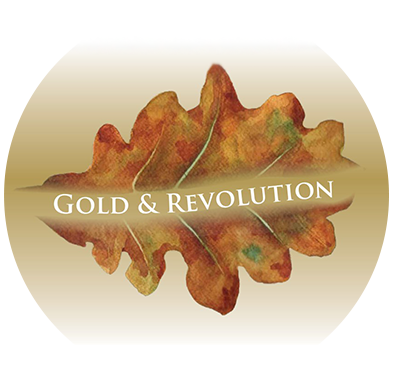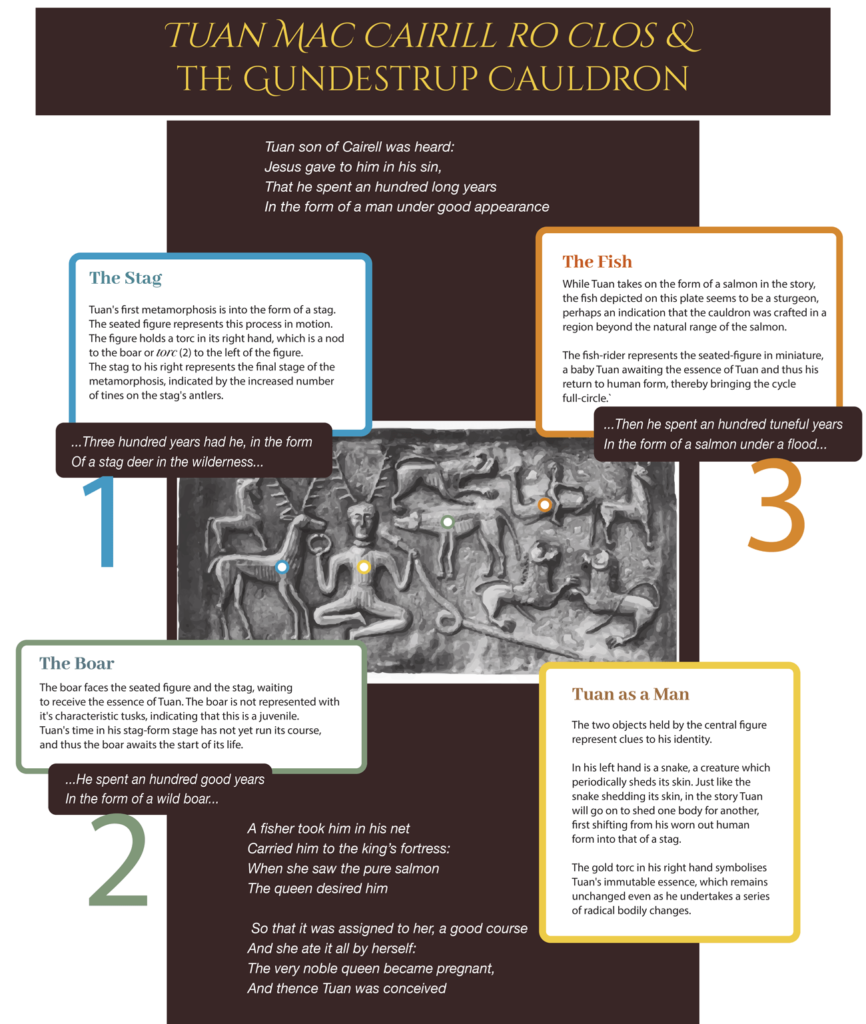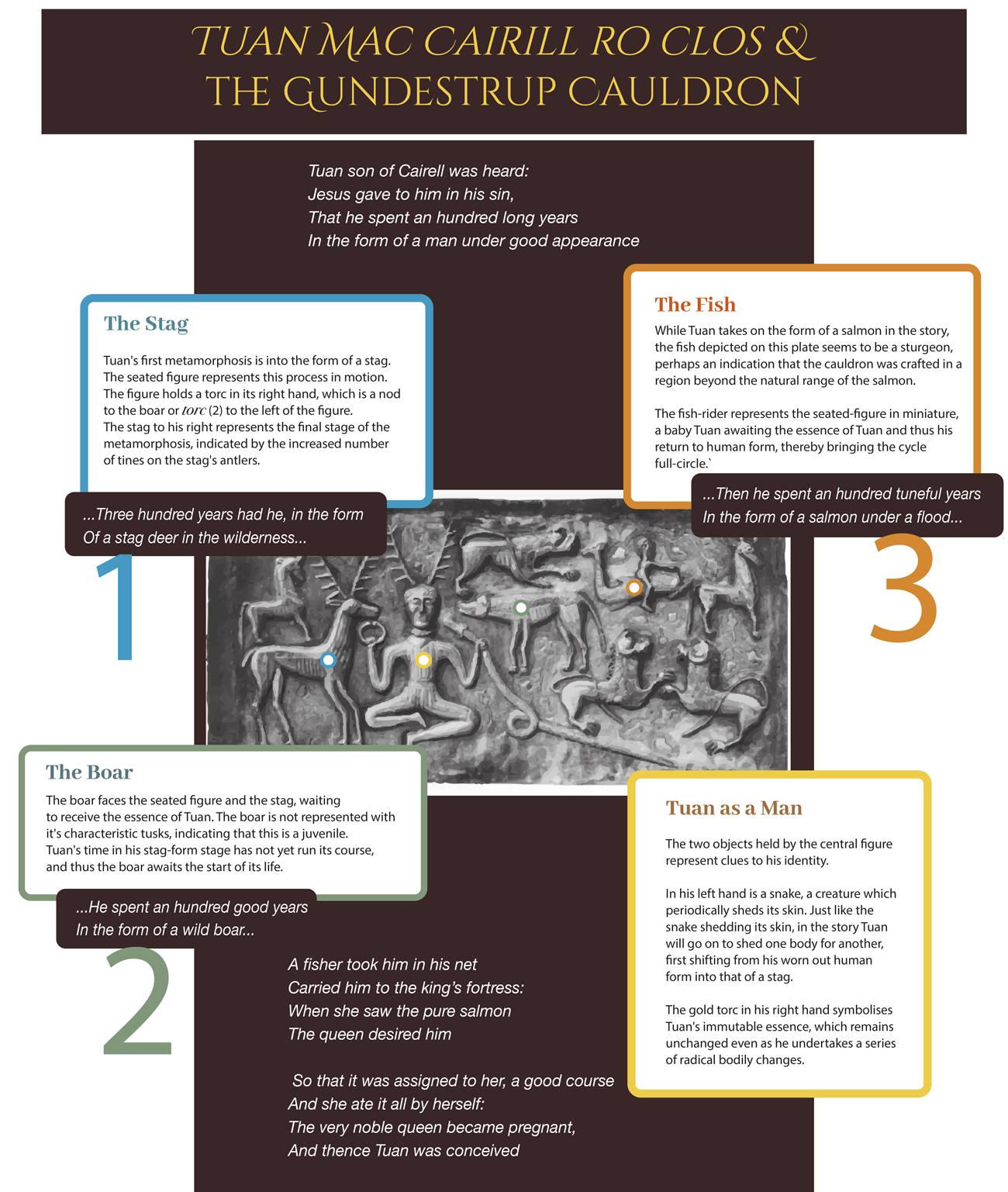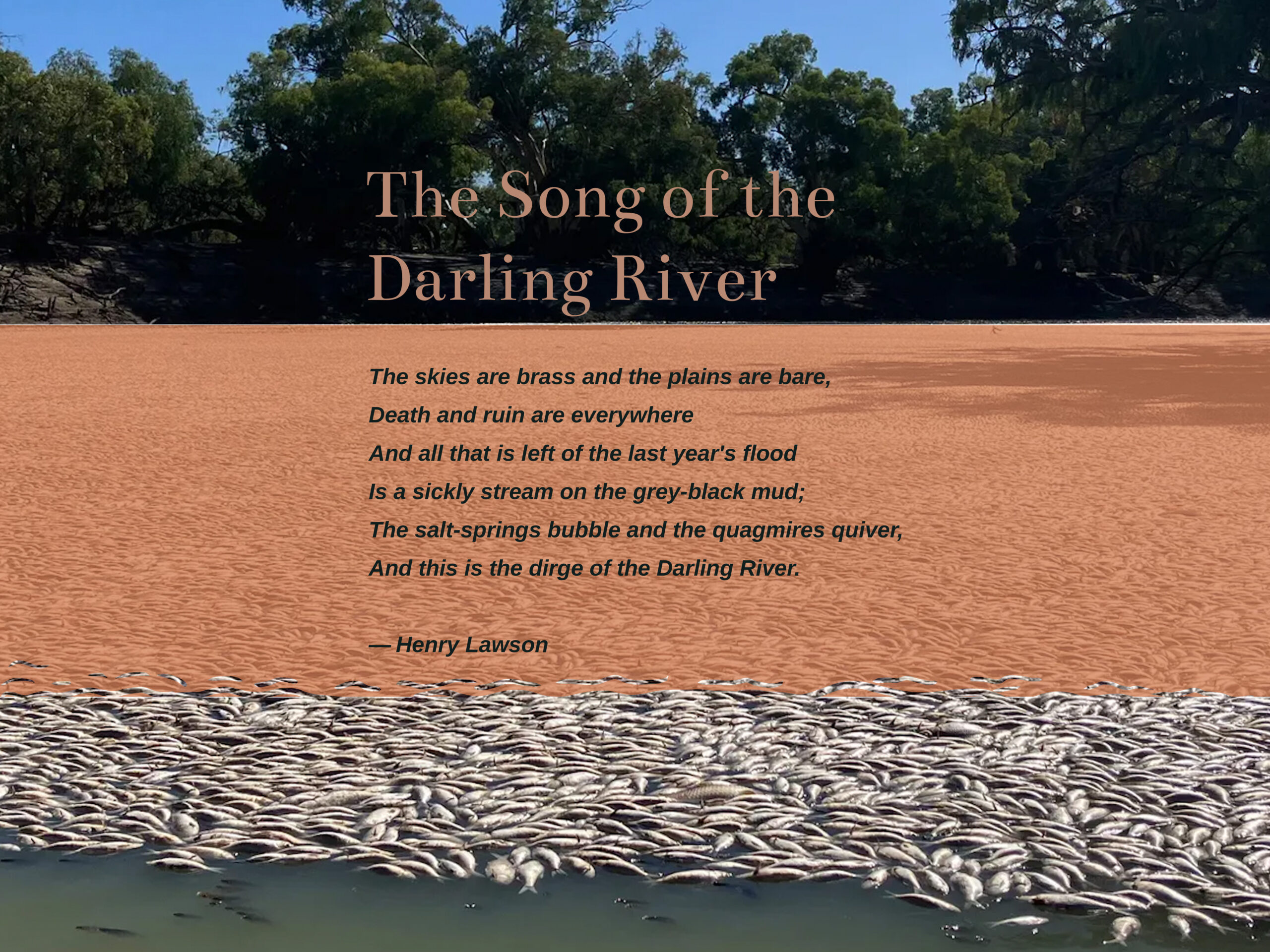Then there grew upon my head
Two antlers with three score points
So that I am rough and grey in shape
After my age has changed from feebleness
Scél Tuáin maic Cairill
In 1891, while working in a bog in northern Denmark, a group of peat-cutters stumbled upon an unusual object within the mire. A closer inspection of the incongruous object beneath the damp peat revealed it to be one of a series of metal plates resting atop a large bowl. Further investigation revealed that the plates fit together to form a cauldron.
The bog in which the artefact was unearthed was close to the hamlet of Gundestrup, and as such the cauldron has been known as the Gundestrup Cauldron ever since.
Immediately after its discovery, the cauldron was taken to the National Museum of Denmark, where a close examination revealed that the multi-part artefact was composed of twelve decorated plates, along with a base-plate and a bowl, all of which had been crafted out of almost nine-kilos of high-purity silver. Traces of gold on some of the images on the plates also indicated that some elements on some of the plates had been gilded with gold.
The cauldron, which today remains on display in the same museum, has for over a century provoked debate as to its meaning and origin, perhaps more so than any other object from the distant past of Europe. (1)
The focus of this article is on just one of the twelve plates of this cauldron, a piece notable on account of a depiction of an enigmatic figure surrounded by a series of animals. This figure has bilked precise identification, and the primary objective of this investigation is to attempt to shine some light on this shadowy entity.
As will be outlined in the argument that follows, both this figure and the miscellany of forms that surround it seem to snugly fit within the context of a traditional story, one which still has some currency today, though curiously, from a land rather distant to Denmark.
The Riddle of Gundestrup
At the time of its unearthing, the Gundestrup cauldron was in a disassembled state, with the twelve decorated silver plates resting inside a large silver bowl. A subsequent inspection of the plates determined that they were designed to fit together back-to back to form a cauldron, though one of the side-panels seemed to be missing.
It was clear from the outset that the artefact was very old. Based on the types of weapons and other accoutrements of war depicted on some of the images decorating the cauldron, the consensus today holds that the cauldron was created not much before, and not much later than, 100 BCE. (2)
Apart from its great antiquity, the fame of the silver cauldron rests on the artful imagery that decorate each of the twelve plates, electric scenes featuring a miscellany of forms, some presumed to be animals and humans, others, monsters and gods.
The exact significance of the iconography on these plates, as well as the question around the origin of the cauldron, has been the subject of sometimes vexatious debate, although there is broad agreement that the iconography is largely Celtic. (3)
Of the twelve surviving plates, one has probably garnered more attention than the others.
Sometimes referred to as either the ‘Master of Animals’ or ‘Cernunnos’ plate, this segment of the vessel is conspicuous both on account of the large number of animal forms that are depicted on the plate, as well as a striking antlered figure displayed in the centre of the piece. This figure is often presumed to be a Celtic deity, sometimes identified as a god called Cernunnos.
This assessment is not universally accepted, and some scholars remain cautious about the traditional designation. Even so, the Cernunnos attribution evidently has some traction today, with most encyclopedia entries on this elusive deity including a reference to the mysterious figure on this panel of the Cauldron. (4) (5)
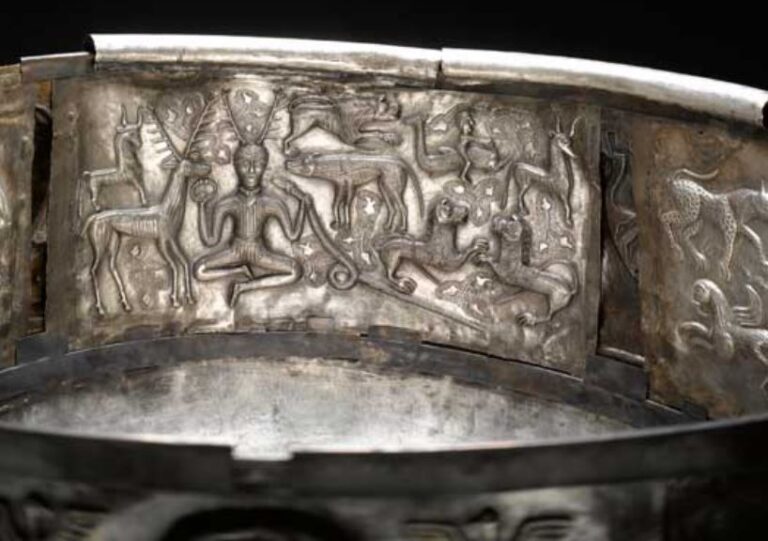
The question of Cernunnos
The notability of this particular plate of the cauldron partly rests on the fact that it seems to be the only surviving indigenous representation of this presumed Celtic god, Cernunnos.
While this is not the only depiction of this nebulous deity that has survived from antiquity, the other portrayals of this horned god that have survived are either vague and open to interpretation, or were otherwise created in Romano-Gaulish setting, in the wake of the conquest of Gaul by the Romans.
The putative name of the god, Cernunnos, is taken from one of such representation, a limestone monument known as the Pillar of the Boatmen. The stone structure was originally erected in Gaul sometime during the reign of the Roman Emperor Tiberius (14-37 AD).

On the monument, the head of Cernunnos is visible, with a pair of antlers or horns on either side of his head, from which two rings, possibly neck-collars known as torcs, are suspended . Inscribed above this figure is the word ‘ERNUNNO’.
As the altar has been weathered over the course of time, the full word is assumed to have originally been ‘Cernunnos’, with the named deity appropriately depicted below (left). (7)
On account of the inscription, the stone-cut visage represents the only unambiguous portrayal of this presumed god, and thus the ‘Cernunnos’ interpretation of the antler-headed figure on the Gundestrup cauldron is contingent on this Gallo-Roman representation.
The identification of the figure on the plate as a deity, and Cernunnos in particular, was commonplace in the 20th century, (8) however, in the later decades of the century, some researchers became leerier about the traditional designation.
This hesitancy partly stems from the fact that, in contrast to other figures on the plate, the humanoid at the centre seems to be proportionate to the animals on either side of him, whereas several other humanoids depicted elsewhere on the cauldron are depicted as massive giants.
The most common interpretation of the towering figures has been that these are intended as representations of gods, with the smaller, proportionate figures depicted representing humans. The seated figure, clearly human-sized, would seem to fall within the latter class, thus leaving a question-mark hovering over the ‘Cernunnos’ interpretation.
However, while there is some circumspection around the god designation, precise identification of this figure has remained elusive.
In the late 1970s, one authority on the cauldron, Garret Olmsted, argued that much of the imagery on the cauldron represented scenes from a Gaulish version of Irish epic, the Táin, and in line with this interpretation, suggested that the antlered figure may have been a representation of the hero of that epic, Cú Chulainn. (9)
While this identification did not garner broad acceptance, it represented a fresh and imaginative approach. Ireland’s deep well of mythology offers an abundance of material to pick through, and given the Celtic iconography on many of the plates, this would seem to be naturally propitious ground to hunt for clues to unlock the puzzle.
Although the Cú Chulainn interpretation is probably amiss, there is another, lesser-known figure from Irish mythology who might be a closer match.
As will be posited below, the animal forms that surrounded this figure may provide the key to resolving the long-standing identity-crisis.
God or humanimal?
In total, there are eleven humanoid and animal forms of this plate, with a pair of horned bulls flanking the top left and right sides of the plate, three carnivores, probably lions, on the right half of the plate, as well as a figure riding a sea-creature in the midst of these beasts.
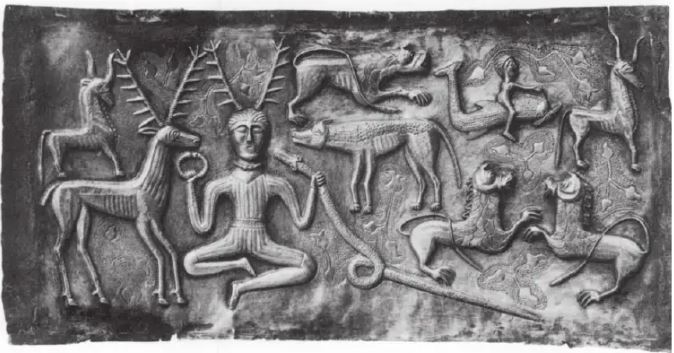
It is clear, however, that the other four forms hovering near, and inclusive of, the antlered-figure are intended to be the centrepiece of the plate.
The most striking figure is the aforementioned seated or squatting figure, sometimes presumed to be Cernunnos, and sometimes, more hazily, labelled the ‘master of animals’ or simply the ‘dieu accroupi’.
The other forms of the central quartet are a horned serpent, which the antlered-figure grasps, a stag standing to the right of this humanoid, and a quadruped to his left, which, like the stag, stares directly at the interposing seated figure.
These last two animals have been rendered with more care than the other animals on the plates, and are the only of the quadruped animals on the plate to be depicted with all four legs.
Leaving the presumed humanimal to one side, the most prominent entity in the piece is the stag positioned to the right of the seated figure, which is one of only two animals on the plate to gaze directly at him. But the most noticeable aspect of this beast is that it shares a common trait with this figure: the antlers of the stag cognate with those of the antlered hominoid.

Although of a similar length, there is one small but significant difference between the antler-pairs of the stag-deer and the stag-man. The antlers of the seated man have fourteen points or tines -seven on each antler- whereas those of the stag has eight per antler, and thus a total of sixteen.
The number of tines on the antlers of a stag roughly correlates with its age, and so the likely intention of the artisan is to indicate that the deer is a little older, a little more developed, than the humanoid with the antlers.
The purpose of this is probably to illustrate that we are not looking at a deer-headed humanoid, but rather an individual changing into a deer, with the deer to his right representing the complete metamorphosis.
In other words, this is probably not a depiction of a god, but of a man, one undertaking a remarkable transformation.
The tale of Tuan Mac Cairill
In the context of Irish mythology, the metamorphosis of a man into a deer-form evokes one figure in particular: the ever-changing Tuan Mac Cairill.
Mac Cairill is a strange, lonely figure. More of a watcher and brooder than a shaker and mover, Tuan Mac Cairill represents a curious counterpoise to the classic archetype of heroic myth.
Today, the tale of Tuan is probably best known for its inclusion in the compilation of Irish Fairy Tales by James Stephens, first published in 1920 and still widely available despite the passage of the years. Stephen’s adaption was a retelling of a Medieval version of the story, although, it is likely that the story was very old even when it was first committed to paper.
In the version of the tale that was popularised by Stephens, Tuan meets the sixth-century Irish saint, Saint Finnen of Moville, to whom he proceeds to relate the details of his colourful life.
Tuan stands as witness to the major events of Ireland’s legendary early history. Himself the survivor of the great plague that wiped out the first major group to settle Ireland, Tuan watches on as Ireland is occupied by successive groups of colonisers from afar, starting with a group led by a great champion, Nemed.
The next wave to arrive is a people known as the Fir Bolg, who are soon driven out by a new group of invaders, the Tuath De Dannan. The Tuath De Dannan eventually succumb to the final group of conquers, known as the Milesians.
As these events play out over the centuries, Tuan embarks upon a remarkable series of changes. Like a caterpillar transforming into a butterfly, Tuan undertakes a series of metamorphoses, living for an extended period through different guises.
First, Tuan transforms from a man into the form of a stag-deer. After leading the life of a stag, he switches form again, becoming a boar. After his time as a boar, Tuan takes to the sky, having transformed into a bird, and thereafter, to the lakes and rivers in the shape of a swimming salmon.
The salmon meets its end in the net of a fisherman, who presents the fish to the local Queen. The Queen eats the fish, becomes pregnant, and the child is Tuan, born again in human form. Tuan inherits the name of Cairill, the King, hence Tuan MacCairill.
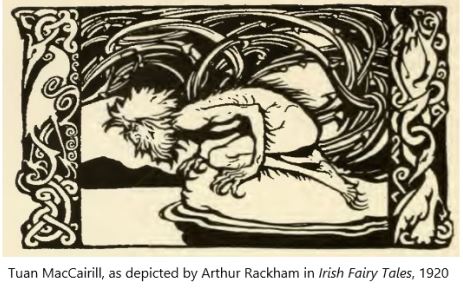
The oldest surviving version of the tale is found within the pages of a late 11th or early 12th century manuscript, (10) known as Scel Tuain Maic Cairill. (11) Presented as a dialogue between Saint Finnen and Tuan, this rendition of the old tale appears to be aimed at transplanting what was probably a pagan-era story into a less objectionable Christian framework.
Scel Tuain is probably derived from an older, poetical form of the tale, known as Tuan Mac Cairill ro clos, the name of the poem deriving from the first line in the original Irish version. The poem form probably bears the closest resemblance to the original spoken-word version of the story. (12)
The poem is structured around the different forms adopted by Tuan over the course of his long life, with the first three stanzas of the poem recounting Tuan’s various incarnations.
Tuan Mac Cairill ro clos
Tuan son of Cairell was heard: Jesus gave to him in his sin, That he spent an hundred long years In the form of a man under good appearance Three hundred years had he, in the form Of a stag deer in the wilderness, (13) He spent an hundred good years In the form of a wild boar Three hundred years had he on flesh When he was in the form of a lonely bird Then he spent an hundred tuneful years In the form of a salmon under a flood A fisher took him in his net, Carried him to the king’s fortress: When she saw the pure salmon The queen desired him So that it was assigned to her, a good course And she ate it all by herself: The very noble queen became pregnant, And thence Tuan was conceived
A medieval Christian influence is readily apparent in the poem, however, it has long been suspected that the tale of Tuan harkens back to Ireland’s distant pre-Christian past. (14)
Despite the not inconsiderable distance between Ireland, the homeland of Tuan, and Denmark, it seems likely that the antlered humanoid figure on this plate of the cauldron might be intended to represent Tuan MacCairill as he undertakes the first of the transformations, as is relayed in Tuan Mac Cairill ro clos.
The first clue, as was noted previously, lies in the relative number of tines on the antlers of the man and the deer. But many other elements displayed on the metalwork would appear to gel with this interpretation.
Over the remaining paragraphs, we will run through each one by one, to illustrate how each of the visual element seems to neatly click into place to relay the story-arc of the tale of Tuan.
The torc and the boar
Interposed between the Stag and the seated humanoid is a torc, held up by the left hand of the seated figure. The torc was an item of jewellery worn about the neck, generally crafted from precious metal, though gold was probably considered the preferred medium.
On the cauldron, all the torcs depicted seem to have been gilded with gold, a sign that the ancient masters of the cauldron perceived an association with the metal and this item of jewellery. (15)
Gold is virtually indestructible, and with this in mind, the gold torc hovering between the man and the deer might possess a potent symbolism: The gold represents the spirit of Tuan, which despite the radical changes in form that he is set to undertake, will remain immutable.
The Celtic word for ‘torc’ was also the word for boar, (16) and one such animal would seem to stand diametrically opposite the torc, the only other animal to stare at the seated humanoid.
This is an important cue, because the boar here is depicted without tusks, the signature characteristic of the animal. The omission of this detail is probably deliberate, with the intent being to show that the boar is a juvenile, still to develop its tusks.
This boarlet is yet to receive the spirit of Tuan, which will serve to kick-start its anima, and so it rests in a kind of stasis, its gaze fixated on the stag as it awaits its turn in the cycle of life.
One of the more confounding aspects of this creature is the tail, which is clearly too long for a boar of any age. However, while this superfluous feature might seem out of place at first glance, a closer inspection reveals that there might be some method in the apparent madness of the ancient smithy.
The tail seems to be a play on the word torc, the item of jewellery and the animal that share the same name. One of the silversmiths has artfully wrought this word association into the cauldron. A close examination of this animal reveals that the tail of the boar has the same helical-pattern as the torc.

The boar or torc seems to have been depicted, perhaps fittingly, with a torc-tail.
The uncertain nature of this animal form on the plate has proven something of a will-o’-the-wisp, leading many a researcher astray. Usually, the animal has been identified as a canine, and at a glance, the animal could certainly pass for a dog. (17) (18)
However, what seems to be an indistinct, carelessly rendered form, may in fact be a craftman’s crafty ruse.
The ambiguity of this form may well be deliberate. Here, the artisan might be attempting to intrigue and beckon us, signalling to the viewer to lean in for a closer look.
And when we do zoom in, one might pick up that the improbably long tail of the animal has the same texture as the torc, which brings to mind the word-association, which in turn reveals the nature of the beast.
So, what appears to be at first glance, an artlessly rendered form, is in fact very artful: The ancient artisan plays a trick on the viewer, upending preconceived assumptions.
The youth on the fish
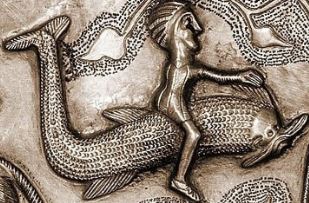
Then there is the curious figure who appears to be riding on the back of a fish, which looks like a representation of the antlered-man in miniature, perhaps now an infant.
This could be seen as a localised interpretation of Tuan’s transformation into a fish, which, after being devoured by the wife of Cairill, saw Tuan reconstituted in human form.
Unlike in the story, the fish depicted here is not a salmon. Another variety of fish seems to have been substituted, perhaps a sturgeon or a catfish, which might serve to indicate that the cauldron was fabricated in a locality beyond the natural range of the salmon.
Three of the singular animal forms on the plate -the stag, boar and fish- seem to concur with three stages of transformation undertaken by Tuan in the medieval Irish version of the tale, with the specific class of fish being the only anomaly.
There is, however, one more notable omission. In the Irish story, Tuan undertakes one more transformation, morphing into a bird, in an intermediate stage between that of the boar and the fish.
There was a gulf of around one thousand years between the fabrication of the Gundestrup Cauldron and the earliest known Irish manuscript containing the Tuan narrative, and the added ‘bird stage’ of the Tuan story is perhaps reflective of the story having grown in the telling over the intervening centuries, the tale gradually becoming more exaggerated as it was retold.
But other than the absence of the bird, Tuan’s changes, from stag, to boar, to fish, and then back into a new human form, would seem to accord very closely to the Irish story.
But can we be certain that the series of animal images depictions are meant to be read in this specific order, conveniently conforming to the story-line of the Tuan’s narrative?
The positioning of both the young boar and stag on the plate are at least suggestive of a connection with the seated figure: each stands on either side of the figure, their gaze fixated on him, the eyes of the two animals level with those of the figure.
But more pointedly, there is a curious system concealed within the background decorations on this plate, which seems designed to function as a visual guide to the viewer, serving as an aid to help make sense out of this chaotic menagerie of forms.
A hidden notation system
In the background of many of the plates of the Gundestrup cauldron there is a pattern resembling plant stems or vines, with most of these strands terminating in a leaf-like motif.
This pattern is particularly conspicuous on the plate that is the focus of this article, where it occurs in eight individual clusters, placed within the empty spaces between different forms. In five instances, the pattern of these clusters consists of three stems, however, there is one cluster with just one stem, and another has several stems and leaves.

A closer inspection of these motifs reveals there are actually two designs: some of the stems terminate not in a leaf, but in a form closer to that of a flower, with one or more stems (left).
This flower-like motif occurs in three places on the plate. One is near the right knee of the antlered-figure, another between the forefeet and hindfeet of the boar, and the third appears between the fish and the bull to the far right.
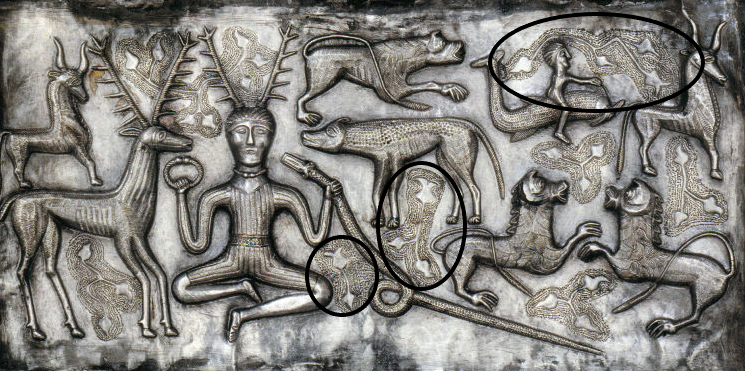
As will be outlined below, the purpose of these motifs is unlikely to be purely decorative. It is very likely that they also serve as a guide, revealing the order with which the narrative that is depicted on the plate should be read.
The single-stemmed flower by the right knee of the Tuan-like figure, indicates that this is the start-point of the narrative (above). Just to the right of this, in the centre of the plate just below the boar, there is a flower with two stems ending in leaves, indicating that this is the next stage of the story. The third flower, on the top right of the plate, has three stems and leaves, and points to this being the third and final stage of the story.
The flower-like shape of these motifs may also be intended to offer up a clue as to the nature of the story, with the flower perhaps symbolising Tuan blooming into a new form, first into that of the stag-deer, second the boar, and finally the fish.
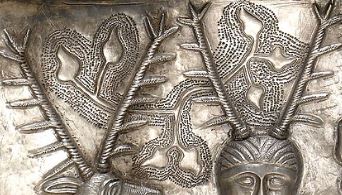
Of the stem-leaf clusters without flowers, there is one other that stands apart from the others. While four of the remaining clusters have three stems and leaves, the other, which seems to wind around the antlers of the man and the deer, has seven leaves.
This is probably intended to signify a psychic connection between the man and the deer: Tuan and the deer are one and the same, with Tuan in the process of transforming into the said animal. (19)
The more common type of cluster on this plate, with three stems and leaves, may also have a function, denoting that the story depicted on the plate is a three-part act.
The hidden notation system in the background of this plate adds considerable clout to the argument that the images are intended to depict a variant of the story of Tuan Mac Cairill, as the ordering of the signal images concurs with the outline of the old Irish tale.
However, other animal forms that feature in the background of the plate, which have so far been unheeded, also would appear to fit into the ‘Tuan’ interpretation. Most notable in this respect are the trio of carnivorous beasts, which we will turn to now.
The lions and the lioness
Three animals on this plate are of a similar appearance, all being depicted with long tails and claws, and their heads bearing similar features. As this trio are the only animals on the plate to be depicted with claws, it would appear that they are meant to represent carnivores.
Two of these fierce beasts are positioned on the lower-right corner of the plate, both adopting aggressive poses, in what seems to be a face-off. Both animals look to have been depicted with manes, and as such it is generally accepted that these are representations of lions.
Near the top of the plate is another carnivore, facing towards the right and positioned directly behind the youth on the fish. The third beast, although in most respects similar, seems to be lacking the mane of the other two animals, and thus this animal has been interpreted as being a lioness. (20)
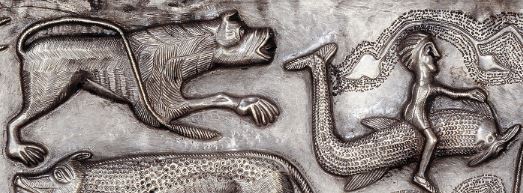
The fact that this lioness seems to be fixated on the fish may be an important clue as to the significance of these three beasts.
In ancient and medieval times, the lion was a symbol of kingship. We might therefore interpret the two lions squaring off on the bottom-right corner of the plate as being a symbolic representation of two kings.
Following on from the same logic, the lioness thus could be interpreted as being symbolic of a Queen.
As was noted earlier, a Queen crops up at the end of the tale of Tuan. It is a Queen who eats Tuan in his salmon form, and thereafter gives birth to a brand new, human version of Tuan.
Thus, the hungry lioness pursuing the fish at the top of this plate may be intended to symbolise the Queen in the story, who would make a meal of the fish and give birth to Tuan.
The Snake
The two last animal forms on the plate are the snake, which the presumptive Tuan grasps in his right hand, and the pair of bulls which stand motionless on either side of the plate.
The snake, which periodically sheds its skin, stands as a symbol of change, and the appearance of one such reptile here foreshadows the process of transformation that is displayed on the plate.
The scaly skin of the snake has been rendered by the ancient silversmith through a pattern of tiny, circular punch-marks. This same technique is found in one other place on this plate: it is also found on the belt of the Tuan-like figure (below).

This overlap is unlikely to be coincidental, for a snake’s skin is a potent allegorical device. Just like a snake shedding its skin, Tuan will soon shed one body for another, first shifting from his worn-out human form into that of a mighty stag.
This snake seems to be depicted with small horns, which might indicate that it is intended to represent an exotic, and thus potentially dangerous, variety of serpent. A venomous snake is an eye-catching motif, and so is probably intended to be one of the first elements on the plate to attract the attention of a viewer.
The snake then, might represent the starting point of the narrative depicted on the plate. The snake, in turn, draws the eye of the viewer to two of the phases of Tuan’s life. Firstly, the snake leads us to the Tuan-like figure, who grasps it in his right hand as he undergoes his first transformation.
It is also notable that the loop in the snake mirrors the shape of the torc held in the opposite hand of the same figure, and so serves to guide the eye to this element on the plate, which, as noted above, is a nod to the boar, just standing to the right of the probable Tuan.
The bulls
Finally, the pair of bulls, the silent sentinels who flank the right and left edges of this plate, are probably intended to serve as bookends for the narrative.
In contrast to the antlers of a deer, which are shed and regrown with each passing year, the horns of a bull are fixed and unchanging.

In Old Irish, the same word is employed for a wild ox and a wild stag: Dam. (21) It is thus possible that the ancient viewer may have drawn a connection between the stag and the bull, and indeed, it is notable that the bull on the far left of this plate is positioned directly on top of the stag. This might be intended to function as a marker that this is the first of Tuan’s changes.
Likewise, it is notable that the flower-motifs that serves as a marker for Tuan’s third stage, his transformation into a fish, is positioned close to the back of the other bull that flanks the top right of the plate. The proximity of this flower to the bull might be intended as a signal that this is the last phase of the Tuan story.
Reading the elements
We might speculate as to how the creators of this ancient object might have intended for the disparate visual elements to be read.
They might have calculated that the snake would be the first element to capture the attention of the viewer. The snaking body of this creature would then lead the eye of the viewer to the Tuan-like figure, who clutches the snake just below its head.
The antlers on the same humanoid would certainly not have escaped the attention of the observer, and this would lead their eye on to the deer to the right of the antlered man.
It is probable that the bull just above the stag was the next element that the ancient observer would notice, and this would draw the eye of the viewer across to the opposite side of the plate, where this bull’s twin is positioned.
This bull, being the last element on the plate, would prompt the eye of the viewer to back-track, shifting from right to left, first to the youth on the fish, and then to the carnivorous beast in pursuit of the fish.
The similar features of this hungry beast to those of the pair of fighting lions at the bottom-right of the plate would reveal this to be a lioness, in turn providing a clue to the identity of the youth riding the fish.
At this point, the only element on the plate left to be unscrambled was the indeterminate beast right in the centre of the plate, and this boar probably served as the crux of the puzzle of the plate.
A riddle wrapped in an enigma?
The visual elements depicted on this plate seem to be intended to relay a narrative, one which would appear to accord very closely to the course of events in the story of Tuan Mac Cairell. It would thus not be unreasonable to conclude that the central figure in the plate is meant to represent Tuan in the process of transforming into a deer.
While it must be acknowledged that any interpretation of an ancient object such as one of the plates of the Gundestrup Cauldron will never fully encapsulate the understanding of those who saw and used the cauldron long ago, the case for Tuan surely holds more water than the traditional interpretation of the figure as Cernunnos, an amorphous divinity whose name is known only from Roman-era inscriptions.
The notion that an ancient object found in Denmark might depict a tale that is normally associated with Ireland may seem odd, but the idea isn’t novel. As noted above, one authority on the cauldron, Olmsted, thought that many of the scenes on the plates corresponded with episodes in the Irish epic the Tain.
The story of Tuan Mac Cairill is not nearly as well known as the Tain, however, and this possibly might be part of the reason why the connection has been previously overlooked.
But while to modern eyes, the most striking image on this plate is the antlered figure with the likeness of Tuan, there may be some reason to suspect that this humanimal form may not have been the element on the plate that was intended to hook the attention of the ancient viewer.
As suggested above, the focal point of the plate may in fact have been the animal at the very centre of the plate, the enigmatic boar.
If so, this would seem to suggest that the plate was not intended to function as a devotional object. Rather, it would appear to have been designed to be a riddle, the very nature this animal serving as the nub of the question.
Indeed, we could conclude by saying that the riddle of the cauldron is that it is exactly that: Perhaps it was intended to be a riddle.
***************************************************************************************************
A number of important questions have been glossed over in this essay.
One of the more pertinent questions relates to those who were at the receiving end of this ancient objet d’art. Who was the target audience for the carefully planned and intricately crafted storyline depicted on this plate?
The iconography on this plate hints at an association with an ancient mining culture, known as the Galatae.
While a further examination of this connection is well warranted, a wander down this winding route would be something of a diversion, and as such this excursion is better left for another day.
We will revisit this subject in a future article on this site.
Appendix
Footnotes
(1) Koch, John, 2006. ‘’Gundestrup Cauldron” in Celtic Culture: A Historical Encyclopedia, ABC-CLIO, p 854
(2) Taylor, T. The Gundestrup Cauldron, Scientific American, Vol. 266, No. 3 (March 1992) p. 85 (view link)
(3) Ibid., p 86
(4) Britannica, The Editors of Encyclopaedia. “Cernunnos”. Encyclopedia Britannica, 12 Jan. 2021, Accessed 6 June 2022 <www.britannica.com/topic/Cernunnos> (view link)
(5) Wikipedia, Wikipedia Contributors. “Cernunnos”. Wikipedia, The Free Encyclopedia, 19 May 2022, Accessed 6 June 2022 <www.en.wikipedia.org/wiki/Cernunnos> (view link)
(6) National Museum of Demark, Accessed 21 May 2022 < www.natmus.dk> (view link)
(7) Summer, Lukas, 2018. The origins of the Gundestrup cauldron – A smorgasbord of elements, scenes and cultural influences of Eurasia, from the Indus Valley to Gallia, p 106 (view link)
(8) Eluere, C, 1993. The Celts, First Masters of Europe, Thames & Hudson, London, p 117
(9) Olmsted, Garret, 1979. The Gundestrup Cauldron: Its Archaeological Context, the Style and Iconography of its Portrayed Motifs, and their Narration of a Gaulish Version of Táin Bó Cúailnge, Latomus, Bruxelles, p 214
(10) Carey, J, 1993. A New Introduction to Lebor Gabala Erenn, Elo Press, Dublin, p 4. Carey suggests that the story developed in the 9th century.
(11) Nutt, Alfred and Meyer, Kuno, 1897. The Celtic doctrine of re-birth, Vol 2, David Nutt, p 294 (view link)
(12) Macalister, R.A.S, 1940, Lebor gabala Erenn: The book of the taking of Ireland, Vol 3, Dublin University Press, Dulbin, p 80.
(13) Ibid., p 80. In the Macalister translation, the original Irish word (fasaigib) is rendered as desert.
(14) Arbois De Jubainville, Henry, 1903, The Irish Mythological Cycle and Celtic Mythology, Hodges, Figgis and co, Dublin, p 35 (view link)
(15) Koch, John, 2006. ‘’Gundestrup Cauldron” in Celtic Culture: A Historical Encyclopedia, ABC-CLIO, p 854
(16) Vendryes, C.J, 1959. Lexique etymologique de l’irlandais ancien, Vol T-U, Paris, p 115
(17) Olmsted, Garret, 1979. The Gundestrup Cauldron: Its Archaeological Context, the Style and Iconography of its Portrayed Motifs, and their Narration of a Gaulish Version of Táin Bó Cúailnge, Latomus, Bruxelles, p 216
(18) Summer, Lukas, 2018. The origins of the Gundestrup cauldron – A smorgasbord of elements, scenes and cultural influences of Eurasia, from the Indus Valley to Gallia, p 103
(19) Ibid., p 104. The foliage pattern linking the antlers of the deer and man have been noted in previous research, though interpreted differently
(20) Ibid., p 103
(21) Vendryes, C.J, 1959. Lexique etymologique de l’irlandais ancien, Vol D, Paris, p
